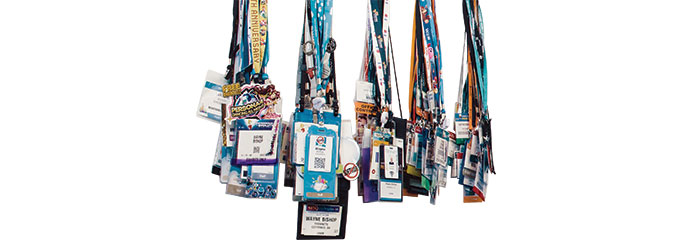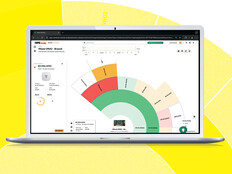City-Sized Networks Rule Today’s Trade Show Circuit
Entertaining speakers? Check. Thought-provoking presentations? Check. Reliable Wi-Fi? Double check.
On today’s conference and trade show circuit, event organizers must build and manage massive, city-sized networks to support increasingly connected attendees.
At the Electronic Entertainment Expo (E3), connectivity is the linchpin of success. For three days in June, 270 exhibitors demoed their computer and mobile games and virtual reality products to more than 52,000 attendees. At the same time, press and other observers tweeted, blogged and uploaded video, audio and reviews showcasing the latest and greatest gaming products.
“If the network goes down, the show goes down,” says Madeline Kruzel, vice president and general manager of IDG World Expo, which manages E3 for the Entertainment Software Association.
The bandwidth and networking requirements for such an event are massive, on par with that of a medium-sized city and up more than 22 percent in 2015, Kruzel says.
The number of unique client networks in need of support during the Electronic Entertainment Expo (E3)
SOURCE: showNets
Unique Networks
IDG World Expo meets those requirements by relying on a unique kind of network specialist. Based in Atlanta, showNets is a leading provider in a new technology service category known as public-venue connectivity.
ShowNets’ specialized service entails design, engineering, installation and operation of customized but temporary enterprise networks for trade shows, conventions, company meetings and other large events.
At E3 2015, showNets provided the core wired and wireless networks for show management, as well as individual networks for each of the 200-plus exhibitors, including Sony, Nintendo and Electronic Arts.
“There’s no way these requirements can be fulfilled by ordering off of some kind of preset menu,” says David Bishop, president of showNets. “We have to custom-build for each of these environments because everyone is running online games and accessing Internet resources. If you don’t have the throughput and the reliability, you’re not going to have that 100 percent uptime everyone needs to ensure success and a great customer experience.”
A Growing Networking Need
Convention centers, hotels and other meeting facilities might have Wi-Fi available, but the network typically does not meet the connectivity needs of such high-transaction, dense gatherings, says Tim Zimmerman, vice president of network infrastructure, mobility and Internet of Things for Gartner.
It’s not only the number of people that complicate connectivity at these events, he explains, but also the reality that attendees and exhibitors likely bring several devices and use them, sometimes simultaneously, to access high-bandwidth services and applications such as streaming video, gaming, surveys and cloud-based applications.
“An existing wireless network built for coverage in an environment like that is going to get overrun very quickly,” Zimmerman says. “Instead, they need a supplemental network where the focus is really on the audience and how they’re going to be using the network to achieve specific business outcomes.” experienced leader
ShowNets is probably the most well-known player in the public-venue connectivity space. Established in 1998, the family-run company has nearly 70 employees and works with major conference and exhibition management firms and large corporations. showNets provides custom-network solutions for six out of the top 10 trade shows listed in the Trade Show Executive’s Gold 100, including E3 and SalesForce’s Dreamforce.
Chief Technology Officer Wayne Bishop says the company succeeds thanks to its long experience — having been in this service industry before the Internet and, later, mobility took off — as well its reliance on top-tier equipment from Cisco Systems and a brain trust of network specialists.
“We’ve got a lot of right-brain thinkers on my team who understand the latest technology and use it to creatively custom-tailor a network based on the event, the budget and the specific needs of the audience,” Wayne Bishop says. “We stay ahead of the curve on technology so we’re always able to provide and take advantage of the newest features and improve our ability to support high-density wireless.”
In this business, no two events are alike. Customer expectations vary widely, and schedules change continuously, along with demand, even as an event unfolds. agility rules.
At a recent corporate event, for example, executives decided to give each of the company’s 2,000 employees a brand-new smartphone — without informing the showNets team, who found out when 2,000 additional connections suddenly appeared on the network.
“We have to be able to adjust and say, OK, what does that mean, how is that going to impact the network and how do we adjust with what we have in place, or don’t have in place?” Wayne Bishop says. “All the while making sure that, bottom line, the experience is not just satisfactory, but well received.”

Network Rising
ShowNets has been working for E3 for 15 years. Wayne Bishop and his team begin preplanning for the event more than six months ahead of time by collecting the unique requirements of each customer and then designing, engineering and testing the various Cisco Systems–based network configurations within its lab.
Part of this effort includes building in full redundancy, with at least two of every critical component included in the final design for guaranteed 100 percent uptime.
“In many ways, this is the most important three days of the year for our exhibitors, so there is absolutely no room for error,” says Madeline Kruzel, vice president and general manager of International Data Group, which puts on E3 for the Electronic Software Association. “showNets is able to talk the talk with the developers of the games and they always do everything in their power to make sure that the network is robust and completely reliable.”
A team of 52 ShowNets engineers then heads to the Los Angeles Convention Center to install the infrastructure. The kicker? They have just three weeks to run 150 miles of network cabling and fiber optics, carefully place switches, access points, antennae and other components, set up monitoring equipment, tie individual networks back to their central NOC servers and into the larger event network, and perform testing.
“When everybody starts using it, it comes to life, and it gets really crazy,” says David Bishop, president of ShowNets. “We monitor it like a doctor monitors a patient, making corrections as we go and taking care of any demand or equipment issues before they become a problem.”








